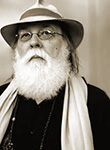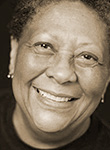Recommendations, Community, and Remembrance
Mary Flinn, Blackbird Founding Editor
Welcome to Blackbird’s In Previous Issues. Here we call your attention to work in our archives that for one reason or another has particular resonance against the work being newly published and/or the moment in which we are publishing. In addition, we will recognize work by old friends who are also current contributors and significant book-length material that we believe deserves steady and ongoing attention.
In many ways, this issue of Blackbird calls attention to friendship, which is, after all, the particular DNA that gives much of life its pleasure and solace. Arts communities of all disciplines and practices and despite various angers and times of distance join individuals in a myriad of ways (through undergraduate experiences, connections to programs, summer conferences, retreats, actual neighborhoods, bars, coffee shops, bookstores, online gatherings, and on and on) that satisfy the heart and engage the mind. And after a year of pandemic isolation, these friendships seem exponentially more necessary even as they seem threatened by forces beyond our control. Is there anyone who in the past year has not lost the opportunity to say a final goodbye to a beloved in the company of other loved ones?
Since Blackbird published v19n2, one of the individuals we have lost is poet, fiction writer, and essayist Richard McCann, who kindly provided poems and an email exchange for v1n2 and the story, “My Brother in the Basement” and a lengthy interview to v3n2. McCann and I had known each other since 1975, when we were both associated with a Richmond weekly newspaper, The Richmond Mercury. We also shared many friends from our separate times at Hollins College—a sterling example of one of those communities of connection.
We were connected as well through our shared friendship with Wesley Gibson, who conducted the interview. McCann called upon his own experience as a source for his work, and noted in his conversation with Gibson:
Often it seems to me that autobiographical writing has in it a kind of doubleness about the painfulness of looking at the self and the ways in which one sometimes feels obliterated and also recreated by examining the self and also by proposing a self in writing.
And in the poem “Letter from the Ground Floor,” he sets out one of the goals of writing specifically from the challenges of the interior life:
I pledge myself forever to transparency
even if I am still sitting here alone like always
not in a good mood not in a bad one either
the sun pouring through the window scrubbing
the walls to the color of milk that luminescence
In the Bible people were lonely though they could wait
for a visitation an angel fluttering down to hear them
or even better yet to whisper a secret in their ears
The sixth annual Claudia Emerson Reading Loop features “Sewing Bird: A Collaboration,” in which Blackbird’s M.A. Keller converses with Carole Garmon, a friend and colleague of Emerson’s from her time teaching at Mary Washington University. Their close friendship led to a collaboration in a 2007 Artists and Writers Exhibition at Randolph-Macon College’s Flippo Gallery that focused on the nineteenth century handwork aid, the actual “sewing bird,” represented by Emerson in a poem and by Garmon with two sculptures. Blackbird’s relationship with Claudia Emerson’s work began in v1n2 with a review of Pinion, her second book. Four poems from the Pulitzer Prize–winning collection Late Wife appeared in v2n1. Other of her Blackbird appearances include the title poems for Secure the Shadow in v9n1 and The Opposite House in v12n1.
Elizabeth King’s essay “Eleanor Rufty: The Moment Between Moments” provides another example of the exercise of friendship as King uses her long familiarity with Rufty to illuminate the elusive mystery that is central to the artist’s recent paintings and drawings. King first appeared in Blackbird v1n1 with her illustrated essay “Clockwork Prayer: A Sixteenth-Century Mechanical Monk.” Other appearances included commentary on artist John Newman in “The Genie of the Station: John Newman’s Skyrider” (co-written with Carlton Newton) in v3n1 and the introduction to the video “VCU Sculpture: The Formative Years” in v11n1.
Also appearing in the suite dedicated to Rufty’s work is Wesley Gibson’s short appreciation of Rufty’s 1997 exhibtion, Voice Over, as Gibson was also Rufty’s close friend.
As an artist recognized for her mastery of the short story by the PEM/Malamud Award, Amina Gautier relies on a grab bag of techniques and tropes examined and employed over a long practice to provide resonance for characters who often operate within severely restricted elements of space and time, elements which could be said to stand in for certain restricted expectations enforced by factors imposed by a wider world. This issue presents Gautier working in a longer form in “Perish,” though with another character who is facing a roadblock in life that is creating severe reconsiderations of what she can accomplish. Blackbird published Amina Gautier’s “Childhood, Princesshood, Motherhood” in v16n1, her story “Hungry, Like the Wolf” in v18n1, and “Dutch” and “Everything” in v19n1.
Another friend of longstanding publishing again in this issue is poet Dave Smith. Earlier works by Smith in Blackbird include the essay, “Larry Levis: Johnny Dominguez, A Letter,” in v2n2, representation as a part of the art exhibition Pivot Points in v3n2, and six poems in v10n1. An audio capture and transcript of the 2017 AWP Panel “Tribute to Dave Smith,” organized by poet Kate Daniels, was published in v17n1. Five new poems are included in this issue, and these lines from “Reading Obituaries” demonstrate how our friends in art help us walk through this world.
. . . At last I leave death alone,
I walk to the pond edge, to shivering water.
There’s always a bigmouth bass blending in
under clouds of minnows gathered like kin.
His gills are slow black fans, his mouth white
as the sky, and they dance into him like angels.
None, it seems, ever skid aside or come back.
Sometimes I watch until night stars take over,
until voices I love start laughing at stories
where Dee sits waiting with wine in her hand.
~
Serial Publications in Blackbird
Blackbird has published two full-length books in our pages and is in the process of publishing two more.
Early on, Blackbird presented the entirety of Norman Dubie’s The Spirit Tablets at Goa Lake, a book-length futurist poem. The poem was issued serially in three parts, beginning with the “Book of the Jewel Worm” in v1n2. It was followed by the other two sections, “Book of the Jaspers” and “The Book of Crying Kanglings,” in v2n1 and v2n2, as well as a helpful introduction and glossary. As Dubie states in a note to the piece,
This futurist poem enjoys the broken narration of its hero, Paul Ekajati, an amateur mathematician who once taught the Calculus on our moon. He is now an exhausted buddhist Vajramaster living in a small village at the Bakavi Lake Mining Colony on Mars. The year is 2277. Yeshe Khandro is in her last black ovum. Or, I should say that a raised mischievous voice in the poem belongs to a dakini “wisdom traveler in space” and that she is the destroyer of the Vega Remnant, LXT. There are eleven spirit tablets.
Nobel Prize–winning author Tomas Tranströmer’s 1996 book Sorgegond olen (Sorrow Gondola), in a new translation by Patty Crane and accompanied by the original Swedish, was published in Blackbird v10n1. To accompany the new translation Jean Valentine provided a letter to the Nobel laureate and David Wojahn presented a compelling meditation on literary friendship and correspondence in “Unlikely Magic, (on Airmail: The Letters of Robert Bly and Tomas Tranströmer).” There, Wojahn states, “The great subject of the poetry of Tomas Tranströmer—sometimes it seems as though it is his only subject—is liminality. He is a poet almost helplessly drawn to enter and inhabit those in-between states that form the borderlines between waking and sleeping, the conscious and the unconscious, ecstasy and terror, the public self and the interior self. Again and again his poems allude to border checkpoints, boundaries, crossroads: they teeter upon thresholds of every sort—be they the brink of sleep or the brink of death, a door about to open or a door about to close.” In v19n1, Blackbird published six new Crane translations of Tranströmer poems.
Since Wesley Gibson’s death in December 2016, Blackbird has contemplated ways to ensure his literary voice maintains a presence in the world. With that end in mind, we are in the process of reproducing his book, You Are Here: A Memoir of Arrival, which was published in 2004 by Back Bay Books. The book, in part, is an account of Gibson’s witness to the HIV/AIDS crisis and its effects in New York City. Hailed at the time by Mary Gaitskill as “dark and sparkling, wonderfully intelligent, flip, and deeply felt,” You Are Here affords an excellent vehicle for honoring Gibson’s many strengths as a writer and his generosity of spirit as a friend. The first installment appeared in v17n1, with the next four appearing in v18n1, v18n2, v19n1, and v19n2. A review of You are Here and a reading by Gibson were published in v3n1. His story, “The Raccoon,” appeared in v10n2.
Marilyn Nelson has for many years celebrated her friendship with Danish writer Inge Pedersen by translating her work, thus making it more available to the Anglophone world. Nelson’s translations of poems from Pedersen’s Den trettende måned appeared in Blackbird v1n1. Her translation of “Clouds and Fire Engines,” an excerpt from Pedersen’s last novel, The Path Leads through the Air, appeared in v18n1, followed by “The Apple” in v18n2, “Seedings” in v19n1, and “Mail” in v19n2. In this issue, Blackbird continues the story with “That’s How It Goes Here.” Nelson herself is the author and translator of more than twenty books of poetry for both children and adults. ![]()









